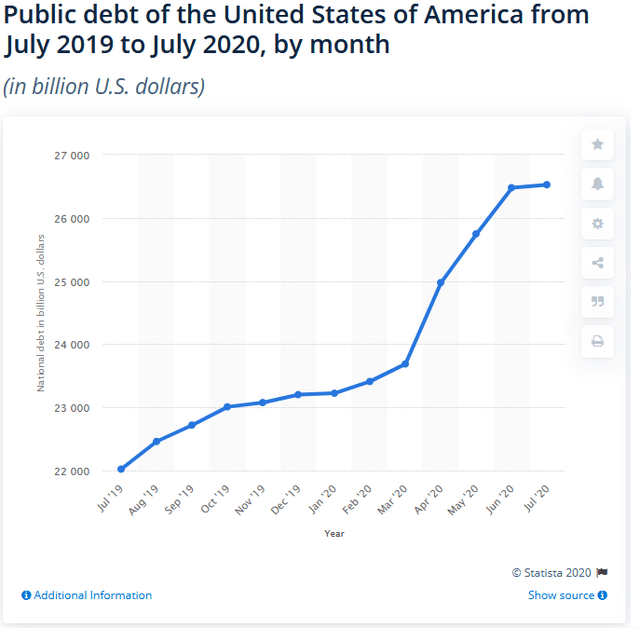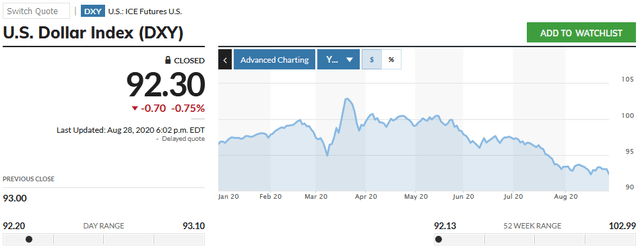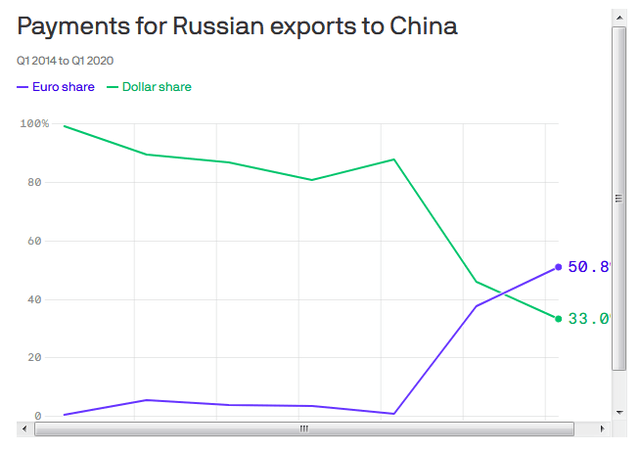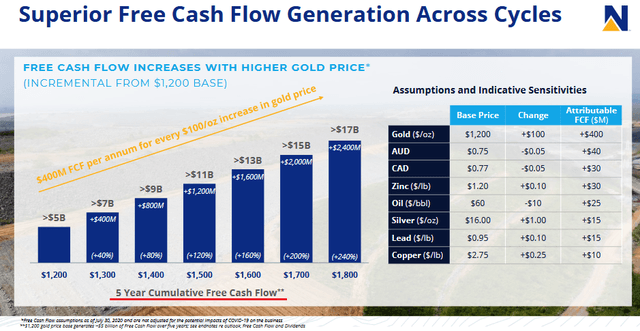When Did We Stop Backing the Dollar With Gold is It Smart to Continue Raising the Debt Ceiling
![]()
Recently, I've been reading about one of the "gold bugs'" favorite topics: the "gold standard." I've even had a plethora of comments on some of my articles from followers and SA users that imply "the end is near, we're headed back to the gold standard". It will never happen. But that doesn't mean I am not bullish on gold, I very much am.
My Favorite Gold Anecdote
To grasp the long-term value of gold as a preservation of wealth tool, an investor need only read this anecdote:
In the early 1900s, a man with a 1-ounce US gold coin with a face value of $20 could buy a very nice suit, shirt, belt, tie, and pair of shoes. Today, what could that $20 buy you - maybe the belt? Yet that 1 ounce of gold, currently worth $1,964, can still easily buy that man a very nice suit, shirt, belt, tie, and pair of shoes. The point is obvious: gold holds its value, and paper currencies do not. Gold is a tool for the preservation of wealth.
US Debt
I am certainly not in denial about the US's massive debt load. In fact, I have mentioned it many times in my articles about gold. Indeed, deficits and the debt load were the main thesis of my article Gold: The Possibility Of A Trump-Induced Bull-Run right after the election back in 2016 (gold was under $1,200/oz at the time).
Let us not forget, the US was already running ~$1 trillion annual federal deficits before COVID-19 hit, after all, massive tax breaks for the super-rich and corporations don't come for free. But, of course, COVID-19 has put the government US$ printing presses in high gear. According to Statistica.com, US public debt has risen 20% just over the past year:

Source: Statistica.com
As a result, and combined with the facts that:
- the US still has widespread COVID-19 infection and community transmission rates
- the US has an unemployment rate over 10%
- the US has seen tens of thousands of small businesses close
- polls show up to 40% of Americans wouldn't take a COVID-19 vaccine if/when one was available.
means the currency printing presses are not likely to slow down any time soon.
"King Dollar"
These developments have led some, including myself, to wonder if the US$ could lose its status as the global reserve currency of choice (see Newmont: How To Profit From The Potential End Of "King Dollar"). Since that article was published, many others have wondered aloud about the possibility (see this Reuters article). As expected, we have seen the US$ dramatically weaken since the onset of the coronavirus and the lack of success in containing it:
 Source: MarketWatch
Source: MarketWatch
Historically, global investors have embraced the US$ in times of crisis - and right after COVID-19 hit the US in March - that again was the case. But since then, the US$ has sold off 10.4% from its high and is now down 4.4% YTD.
Combined with Fed chair Powell's recent speech indicating the Fed's willingness to let inflation run above its historical 2% target before raising interest rates. Bottom line (again) is that US interest rates are likely to stay low for a long, long time. The good news: it makes the cost of issuing all that debt discussed previously much cheaper.
I was amazed to see gold sell off ~1% directly after the speech and was wondering if everyone heard the same words from Powell that I heard. It was irrational, as the next day proved when gold turned around and gained about 2%.
The Gold Standard
All of these developments have prodded the gold bugs to their favorite topic: bringing back the gold standard. Yet, there is no indication that the US - let alone the world - would, or even could, bring back the gold standard. Back in 2017, I wrote the Seeking Alpha article The Price of Gold If The US Was Still On The Gold Standard. Feel free to read the details of the calculation, but in short, the answer (at that time) was $5,228/ounce.
At the time, the US debt hadn't yet crossed $20 trillion, and of course, the Fed balance sheet has greatly expanded as well. The point is that the magnitude of "the problem" is, in a word, huge. After all, it was France exchanging its US$ currency note for gold that was the final straw that forced Nixon to end international convertibility of the U.S. dollar to gold on August 15, 1971. Certainly, US gold reserves have not kept pace with the rapid debasement of the US$ since then, so if it was a "problem" in 1971, it is a much bigger problem today.
Yet some investors/historians want to revisit the empires of Rome and the UK and point out how debasement of those currencies led those powers losing their default status as the reserve currency of choice. They also draw parallels with the path the US empire is on today. No argument with me concerning history. That said, it doesn't mean the US, let alone the world, will go back to the gold standard anytime soon. After all, the UK didn't go to the gold standard after the pound lost its position as the world's leading currency. In fact, no country is on the gold standard today, the last being Switzerland which left it two decades ago.
US$: The Global Reserve Currency of Choice
However, "the problem" hasn't been all that bad (for the US$...) because it has greatly benefited from being the world's reserve currency of choice (sometimes referred to as the "Exorbitant Privilege"). Here are three big advantages:
- Being able to print the trillions and trillions of US$ denominated debt and finding global investors to buy it.
- A tool for enabling the US to use a US$ denominated global banking system to pressure foreign countries - via sanctions or otherwise - to act according to US foreign policy.
- Being able to run massive trade deficits.
It also hasn't been "all bad" from the standpoint that millions of people around the planet have been lifted out of poverty during the reign of the US$ (including hundreds of millions in China), opening up big markets for US products and services at the same time.
That said, many foreign countries that do not enjoy these privileges, and/or find themselves suffering as a result of them, would like to see a change and resent the massive debt the US has been able to rack up. As Axios currently reported, there's been a big change in US$ denominated trade between China and Russia, with the euro taking over:
 Source: Axios
Source: Axios
In addition, China and Russia also conduct energy trade between themselves in their native currencies. And as I reported, in 2017, China - now the world's #1 oil importer and #2 oil consumer - developed a new gold-backed oil futures contract to specifically cut the US$ out of those deals.
Special Drawing Rights ("SDRs")
Enter the "SDR" concept. Special Drawing Rights are supplementary foreign exchange reserve assets defined supported and maintained by the International Monetary Fund ("IMF"). SDRs were created in 1969 to supplement a shortfall of preferred foreign exchange reserves - namely the US$ and gold. SDRs (in XDR units) are a basket of five currencies:
There had been discussions to add gold and silver and perhaps other precious metals to the basket.
NOTE: Initially, its value was fixed at 1 XDR = 1 U.S. dollar (as equivalent to 0.888671 grams of fine gold), but this was abandoned in favor of a currency basket after the 1973 collapse of the Bretton Woods system of fixed exchange rates.
So, it's clear, at least to me, that global finance ministers and the IMF have been tussling with "the problem" for decades now, and the best "solution" they came up with was SDRs. That is likely to be the case in the future. And if the US loses its status as the world's reserve currency, it is likely its % weighting in the SDR "basket" will fall. It is also likely that if China's economy keeps growing, its weight in the basket will rise (one reason I have invested in the SPDR S&P China ETF (GXC)).
Any investor investing in gold simply for as a "hope and a dream" that the US, or the world in general, will return to the "gold standard" - that stopped working decades ago - will likely be disappointed in that opinion. But they will be happy because they likely hold gold, and that will, I have no doubt, continue to appreciate (especially in US$ terms). In fact, I think the popularity of Bitcoin is a sign that investors not only don't believe a gold standard will return, they believe well-designed digital currencies are the future.
It's Not An "Either/Or"
A person can believe that the US won't go back to the gold standard (as I do) and still be bullish on gold (as I am). The two are not mutually exclusive. I am bullish on gold because, as an American, my savings and investments are predominately based on a currency that is being rapidly debased. As a result, I want to hedge that by buying gold and silver and miners and investments like the GXC ETF. I've allocated a specific amount in my portfolio as a "preservation of wealth" bucket in case of a big drop in the US$. That bucket has done very well over the years.
Newmont (NEM) is the only individual mining stock I own; the rest I own through the Fidelity Select Gold Portfolio (FSAGX). I like Newmont due to its tremendous free cash flow potential and a management team that has proven itself to be shareholder-friendly. As a result, I expect significant dividend growth over the coming years.
The chart below shows how nicely levered Newmont is to higher gold prices:
 Source: August Presentation
Source: August Presentation
This chart is a bit misleading, and so I underlined "5 Year Cumulative FCF" in red. Not sure why the company presents the bar graph like that - I think it is their way of telling shareholders they won't be running out of gold producing assets any time soon. Perhaps, a better way to look at Newmont is by picking out the highlights of their Q2 EPS report:
- Produced 1.3 million ounces of gold
- Had an AISC = $1,097/oz (all-in-sustaining cost)
- Had an average realized price for gold of $1,724
- Generated $388 million of Free cash flow
Note that gold is currently $200/oz+ higher as compared to the Q2 average realized selling price. Also, note that $388 million in FCF equates to $0.48/share (based on 805 million fully diluted shares). The bodes well for near-term dividend growth, considering the Q2 dividend was only $0.25/share.
Summary & Conclusion
The US, whether its currency loses its status as the global reserve currency of choice or not, will not be going back to the gold standard. Neither will any other country on Earth, in my opinion. What is likely to happen is that SDRs will play a growing and more important role in global trade as the world moves away from the US$. I also predict the Chinese yuan will also play an increasingly larger role in the basket of currencies that comprise an SDR.
What can Americans do to preserve their wealth through such developments? Buy gold & silver bullion, but the GXC ETF, buy a mining stock like Newmont, or buy a gold miners fund like FSAGX. Good luck to you!
This article was written by

Technology stocks, ETFs, portfolio strategy, renewable energy, and O&G companies. Primary goal is growing net-worth. I typically allocate a portion of my own portfolio and devote some of my SA articles to small and medium sized companies offering compelling risk/reward propositions. I am an Electronics Engineer, not a qualified investment advisor. While the information and data presented in my articles are obtained from company documents and/or sources believed to be reliable, they have not been independently verified. Therefore, I cannot guarantee its accuracy. I advise investors conduct their own research and due-diligence and to consult a qualified investment advisor. I explicitly disclaim any liability that may arise from investment decisions you make based on my articles. Thanks for reading and I wish you much investment success!
Disclosure: I am/we are long GXC, FSAGX, NEM. I wrote this article myself, and it expresses my own opinions. I am not receiving compensation for it (other than from Seeking Alpha). I have no business relationship with any company whose stock is mentioned in this article.
Additional disclosure: I am an engineer, not a CFA. The information and data presented in this article were obtained from company documents and/or sources believed to be reliable, but have not been independently verified. Therefore, the author cannot guarantee their accuracy. Please do your own research and contact a qualified investment advisor. I am not responsible for the investment decisions you make.
Source: https://seekingalpha.com/article/4371805-u-s-dollar-back-on-gold-standard-never-happen
0 Response to "When Did We Stop Backing the Dollar With Gold is It Smart to Continue Raising the Debt Ceiling"
Post a Comment